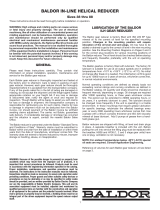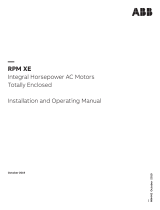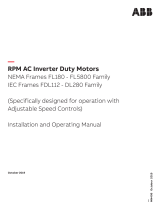Page is loading ...

1
WARNING: To ensure that drive is not unexpectedly started,
turn off and lock out or tag power source before proceeding.
Failure to observe these precautions could result in bodily
injury.
INSTALLATION INSTRUCTIONS
NOTE: Hinged cap pillow blocks must be base loaded.
Installing Bearing on Shaft:
1. Install non-expansion bearing rst.
2. Shaft should be within commercial tolerances, straight,
smooth and clean. Apply a thin coat of light oil on the shaft.
3. Back off setscrews until they are stopped by deformed
threads in end of adapter.
4. If necessary to expand adapter, loosen adapter nut and tap
on end of this nut.
5. Slide bearing on shaft and locate where desired.
6. Do not bolt outer housing to support until bearing is
tightened on shaft.
7. Block up shaft, if possible, to remove weight from bearing.
8. To keep adapter from turning on shaft, tap on large end
opposite adapter nut. If large end of adapter is inaccessible,
insert point of screwdriver between housing and adapter
nut and twist screwdriver.
9. Tighten (turn clockwise) adapter nut with wrench.
10. When considerable effort is required to turn adapter nut,
hammer on end of nut using a soft steel or brass drift
while turning with wrench. When adapter seems to be
tight, also use a hammer on the wrench while hammering
simultaneously on end of adapter nut.
11. Lock adapter nut by bending one prong of lockwasher into
corresponding notch in back of the nut.
CAUTION: Never loosen adapter nut to next
locking position.
12. Check hold-down bolts in outer housing to see that they
are loose and free. (If too tight, an excessive thrust load
could be imposed on bearing.) If bolts are very tight, it may
be advisable to loosen adapter to move slightly on shaft.
13. Expansion Bearing: Inner unit should be located with unit
housing in center of outer housing so unit can move freely
in either direction. Loosen hand knob in outer housing a
little so unit is free to align in outer housing. Tighten hold-
down bolts. Retighten hand knob.
WARNING: Because of the possible danger to person(s) or
property from accidents which may result from the improper
use of products, it is important that correct procedures be
followed. Products must be used in accordance with the
engineering information specified in the catalog. Proper
installation, maintenance and operation procedures must be
observed. The instructions in the instruction manuals must
be followed. Inspections should be made as necessary to
assure safe operation under prevailing conditions. Proper
guards and other suitable safety devices or procedures, as
may be desirable, or as may be specified in safety codes
should be provided, and are neither provided by Baldor
Electric Company, nor are the responsibility of Baldor Electric
Company. This unit and its associated equipment must be
installed, adjusted and maintained by qualified personnel
who are familiar with the construction and operation of all
equipment in the system and the potential hazards involved.
When risks to persons or property may be involved, a holding
device must be an integral part of the driven equipment
beyond the speed reducer output shaft.
DODGE
®
HINGED CAP PILLOW BLOCKS
WITH TAPERED ROLLER BEARINGS
These instructions must be read thoroughly before installation or operation.
14. Non-Expansion Bearing: Loosen hand knob in outer
housing a little so unit is free to align in outer housing.
Tighten hold-down bolts. Retighten hand knob.
15. After a short run make sure adapter is tight as follows:
loosen hold-down bolts and unlock adapter nut by bending
out prong; perform steps 7, 9, 10 and 11. Tighten hold-
down bolts.
Removing Bearing from Shaft:
1. Unlock adapter nut by bending out prong of adapter nut
lock washer.
2. Loosen hold-down bolts. Block up shaft, if possible, to
remove weight from bearing.
3. Loosen adapter nut about one turn, and tighten setscrews
on opposite end of bearing until tapered roller bearing
cone is free on adapter. Bearing can then be pushed off
the shaft. If difculty is encountered dislodging the cone, it
is suggested to hammer simultaneously on end of adapter
nut using a drift rod while tightening setscrews on opposite
end of bearing.
LUBRICATION INSTRUCTIONS
Normal Operation—This bearing has been greased at the factory
and is ready to run. The following table is a general guide for
relubrication. However, certain conditions may require a change
of lubricating periods as dictated by experience. See “High Speed
Operation” and “Operation in Presence of Dust, Water or Corrosive
Vapors.” When establishing a relubrication schedule, note that a
small amount of grease at frequent intervals is preferable to a
large amount at infrequent intervals.
Table 1 - Lubrication Guide
Hours
Run
per
Day
Suggested Lubrication Period in Weeks
1
to
250
RPM
251
to
500
RPM
501
to
750
RPM
751
to
1000
RPM
1001
to
1500
RPM
1501
to
2000
RPM
2001
to
2500
RPM
2501
to
3000
RPM
8 12 12 10 7 5 4 3 2
16 12 7 5 4 2 2 2 1
24 10 5 3 2 1 1 1 1
Operating Temperature—Bearing inner unit housing temperature
at or above 175ºF may indicate faulty lubrication. Bearing housing
temperature at or above 175ºF accompanied by excessive leakage
of grease indicates too much grease. 175ºF or higher temperature
with no grease showing at the seals, particularly if the bearing
seems noisy, usually indicates too little grease. Temperature
below 175ºF and a slight showing of grease at the seals indicate
proper lubrication.
High Speed Operation—In the higher speed ranges too much
grease will cause overheating. The amount of grease that the
bearing will take for a particular high speed application can only
be determined by experience—see “Operating Temperature.”
If excess grease in the bearing causes overheating, it will be
necessary to remove grease tting (also drain plug when furnished)
to permit excess grease to escape.

P.O. Box 2400, Fort Smith, AR 72902-2400 U.S.A., Ph: (1) 479.646.4711, Fax (1) 479.648.5792, International Fax (1) 479.648.5895
Dodge Product Support
6040 Ponders Court, Greenville, SC 29615-4617 U.S.A., Ph: (1) 864.297.4800, Fax: (1) 864.281.2433
www.baldor.com
A MEMBER OF THE ABB GROUP
Operation in Presence of Dust, Water or Corrosive Vapors—
Under these conditions the bearing should contain as much
grease as speed will permit, since a full bearing with consequent
slight leakage is the best protection against entrance of foreign
material. In the higher speed ranges too much grease will cause
overheating—see “High Speed Operation.” In the lower speed
ranges it is advisable to add extra grease to a new bearing before
putting into operation. Bearings should be greased as often as
necessary (daily if required) to maintain a slight leakage at the
seals.
Special Operating Conditions—Refer acid, chemical, extreme
or other special operating conditions to Dodge Application
Engineering, 864–284–5700.
Storage or Special Shutdown—If exposed to wet or dusty
conditions or to corrosive vapors, extra protection is necessary;
Add grease until it shows at the seals; rotate the bearing to
distribute grease; cover the bearing. After storage or idle period,
add a little fresh grease before running.
Kind of Grease—Many ordinary cup greases will disintegrate at
speeds far below those at which DODGE bearings will operate
successfully if proper grease is used. DODGE bearings have
been lubricated at the factory with No. 2 consistency Lithium
complex-base grease. Relubricate with Lithium complex-base
grease or a grease which is compatible with original lubricant and
suitable for roller bearing service. In unusual or doubtful cases
the recommendation of a reputable grease manufacturer should
be secured.
© Baldor Electric Company
MN3019 (Replaces 499772)
All Rights Reserved. Printed in USA.
5/11 TCP 20,000
*3019-0511*
Insert Housing
/



